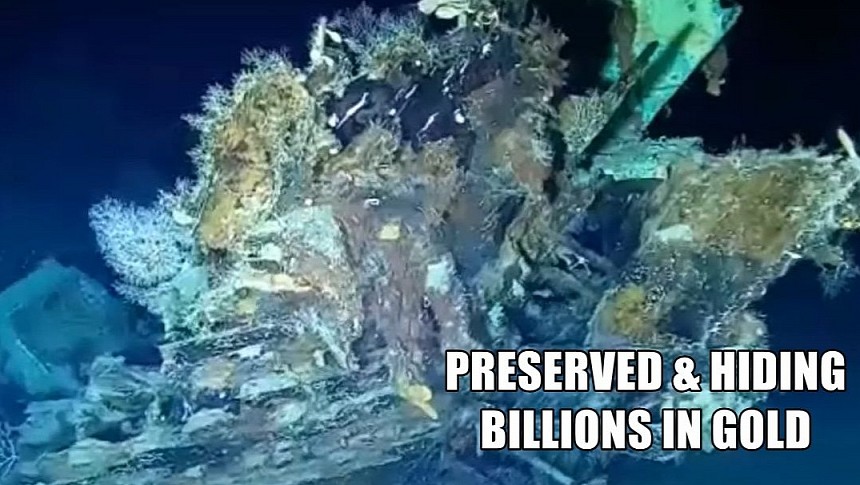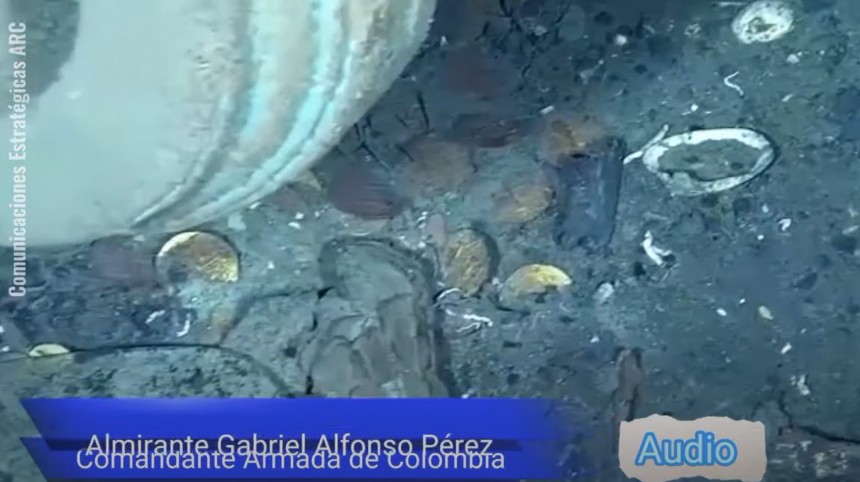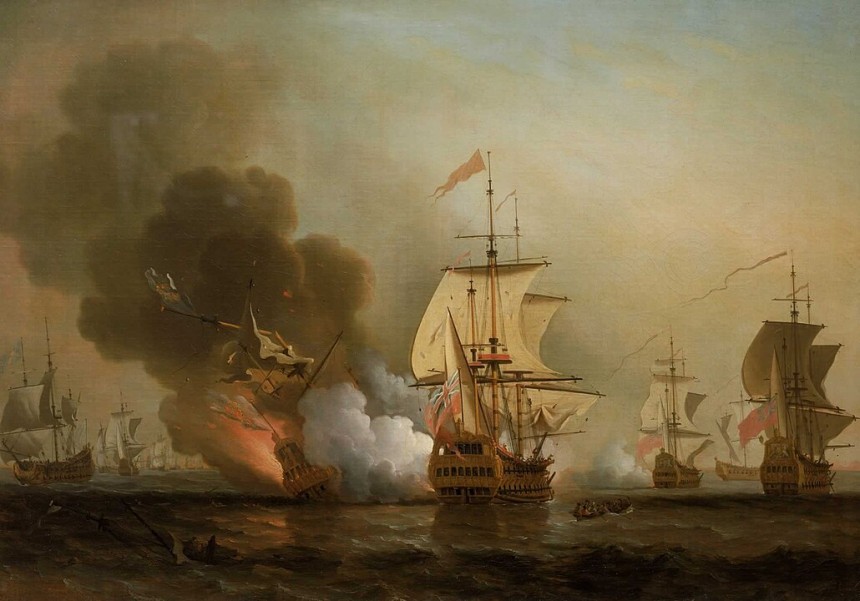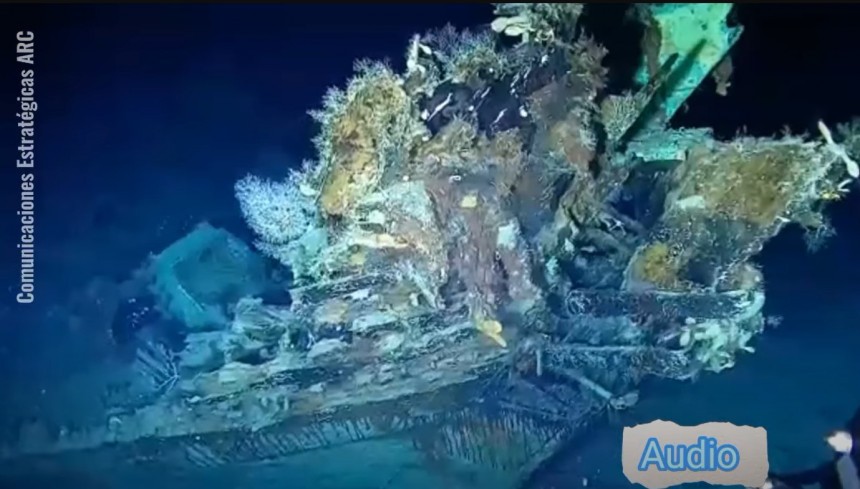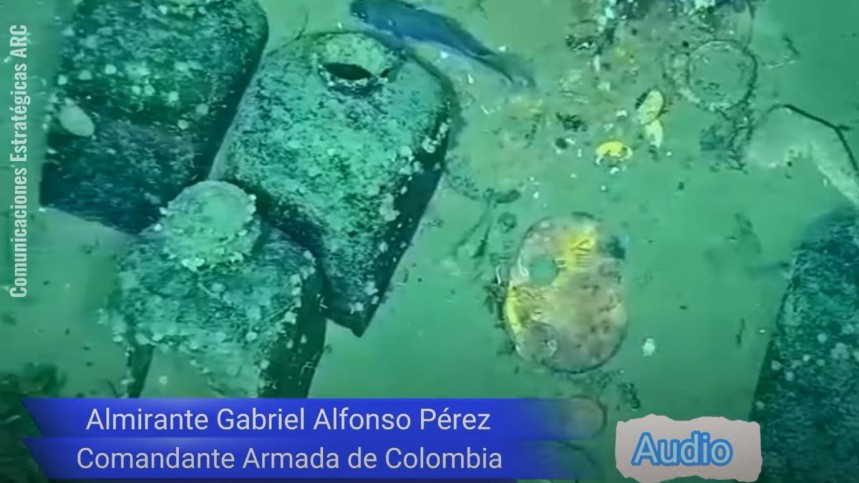Everybody loves a good treasure hunting story... as long as it doesn't happen in real life, under current international legislation. The discovery of the San José galleon and plans to have it excavated by 2026 are solid proof of that.
Often described as the Holy Grail of Shipwrecks (capitalized, too), San José is a Spanish galleon that sank during a battle called Wager's Action when a fleet of Spanish ships laden with goods stolen from the New World tried and failed to outrun the Royal Navy – the HMS Expedition, helmed by Commodore Charles Wager, specifically in the case of San José.
San José sank in the Caribbean as it faced the HMS Expedition and, over the years, became a myth – the one shipwreck no treasure hunter could find, but everyone tried to. You see, like sister ship San Joaquín, with which it led the Tierra Firma fleet, San José was packed with years' worth of looting, including gold, silver, coin, and precious gems.
Then, in 2015, then-President of Colombia Juan Manuel Santos proudly announced that the galleon had at long last been found, coincidentally just two years after he had passed legislation that allowed the local government to declare whatever shipwreck and its contents they came across national property by being part of the cultural heritage.
The plan was to bring it up by 2018, but San José hasn't budged an inch in the years that passed due to ongoing legal disputes over who discovered it, who owns the ship, and, most importantly, who owns the treasure onboard.
Current President Gustavo Petro is now saying that the wreck will be excavated by the time he ends his run in 2026. Petro insists Santos' original plan of building a museum to put the hull and some of the items onboard on display still stands, just like he insists Colombia is the rightful owner of the treasure the galleon carried when it went under.
Considering said fortune is valued at anything between $10 billion and $20 billion, that's no small thing to claim.
All were carrying treasures collected over several years in the New World, but San José did most of the heavy lifting in this sense, if only on account of its size. The estimates of the value of that treasure come from accounts of what sister ship San Joaquín brought in, but they were never verified.
At the time, Spain was engaged in the War of Succession with the British Empire, and the loot onboard these vessels would have tipped the balance in favor of whoever got their hands on it. So, Royal Navy ships were sent out to intercept the Tierra Firma fleet.
Ironically, San José didn't sink in battle but during a short reprieve from it, when its own powder magazines exploded, effectively tearing the ship in half and sinking it in just a few minutes. It all happened so fast that, of the 600 people onboard, only 11 survived.
When Santos announced the galleon had been discovered in 2015, it was a shock to everyone but U.S.-based company Glocca Morra, which had already found the wreckage site as early as 1981 – and had shared the location with the Colombian government. According to court documents, Glocca Morra had been set up specifically for the purpose of finding the lost galleon, and they'd worked with the Colombian government from day one.
Glocca Morra conducted the first two phases of the search with a side-scan sonar and an ROV (remotely operated vehicle) and initially discovered a single cannon believed to match the description of those onboard San José.
It would be a while before they could gather more funds for phase three, which saw the use of the civilian submarine Auguste Piccard, previously used during the 1964 Swiss expo to take tourists to the bottom of Lake Geneva. It was then that the sonar picked up a ship-like anomaly on the ocean floor at a depth of 200 meters (656 feet).
The findings were shared with the Colombian authorities right away, but they also changed the nature of the understanding Glocca Morra had initially made with them – which would have landed the explorers 45% of whatever they found. The government offered them just 25% now, and when Glocca Morra turned down the offer, they were banned – and then forcibly kept – from exploring the area ever again.
Glocca Morra has since been absorbed by Sea Search Armada (SSA), which has carried on the litigation against the state of Colombia. In 2007, the country's Supreme Court ruled that SSA is entitled to half of what is found on whatever wreck they came across, but the decision never went into effect: the military has kept them away, and the ruling was virtually annulled with the 2013 law that claimed discoveries in Colombian waters were national heritage, regardless of whoever found them.
For starters, San José is said to be lying at some 600 meters (1,970 feet) underwater, deep in mud, which researchers believe accounts for the incredible state of preservation it's in. Credit for the discovery goes to Woods Hole Oceanographic Institute, which also contributed to locating the Titanic, based on data provided by archaeologist Roger Dooley, and with backing from financier MAC (Maritime Archaeology Consultants).
Photos and footage taken with a REMUS 6000 autonomous underwater vehicle show the bronze guns engraved with dolphins, coins scattered on the ocean floor, and still-intact porcelain tea sets. The kind of treasure just lying around the ocean floor hints at the real treasures inside – below deck, where the gold, the silver, and the gems were said to be carried.
All this explains the decision to speed up the recovery of the galleon. But the fact that all this will go directly into the vaults of the country's central bank explains it best. San José is part of the cultural national patrimony, but the riches on it are not because of something called the concept of repetition. This means that artifacts in multiple interchangeable examples, like coins or uncut stones, qualify as treasure and that only the first specimens in a series are patrimony.
For one, Spain is invoking the principle of sovereign immunity to claim the wreck: a warship belongs to the nation whose flag it was sailing under, even after it sinks. Peru and Bolivia have also shown an intention to claim the riches on the grounds that most of the gold and silver onboard had been mined on their land by their own people and, as such, was looted.
Ownership should ideally be settled before the 2026 planned recovery. Whatever happens, the issue of ownership definitely dwarfs the question of who found the wreck first, finder's fee or not.
San José sank in the Caribbean as it faced the HMS Expedition and, over the years, became a myth – the one shipwreck no treasure hunter could find, but everyone tried to. You see, like sister ship San Joaquín, with which it led the Tierra Firma fleet, San José was packed with years' worth of looting, including gold, silver, coin, and precious gems.
Then, in 2015, then-President of Colombia Juan Manuel Santos proudly announced that the galleon had at long last been found, coincidentally just two years after he had passed legislation that allowed the local government to declare whatever shipwreck and its contents they came across national property by being part of the cultural heritage.
The plan was to bring it up by 2018, but San José hasn't budged an inch in the years that passed due to ongoing legal disputes over who discovered it, who owns the ship, and, most importantly, who owns the treasure onboard.
Considering said fortune is valued at anything between $10 billion and $20 billion, that's no small thing to claim.
San José, the flagship of the Tierra Firma fleet
Launched in 1698, San José was a three-masted, 64-gun galleon of the Spanish Armada de la Guardia de la Carrera de las Indias. When it sunk in the battle of Wager's Action in 1708, it was making its way from Portobelo, Panama, to Cartagena, Colombia, together with a treasure fleet composed of three warships and 14 merchant vessels, called the Tierra Firma fleet.All were carrying treasures collected over several years in the New World, but San José did most of the heavy lifting in this sense, if only on account of its size. The estimates of the value of that treasure come from accounts of what sister ship San Joaquín brought in, but they were never verified.
At the time, Spain was engaged in the War of Succession with the British Empire, and the loot onboard these vessels would have tipped the balance in favor of whoever got their hands on it. So, Royal Navy ships were sent out to intercept the Tierra Firma fleet.
The initial discovery of San José
Treasure hunting started picking up speed in the late 1950s when tech finally allowed for deeper and longer dives. Because of countless reports of the treasure onboard, San José became a legend in its own right – and more famous with each expedition that failed to return the expected discovery.When Santos announced the galleon had been discovered in 2015, it was a shock to everyone but U.S.-based company Glocca Morra, which had already found the wreckage site as early as 1981 – and had shared the location with the Colombian government. According to court documents, Glocca Morra had been set up specifically for the purpose of finding the lost galleon, and they'd worked with the Colombian government from day one.
Glocca Morra conducted the first two phases of the search with a side-scan sonar and an ROV (remotely operated vehicle) and initially discovered a single cannon believed to match the description of those onboard San José.
It would be a while before they could gather more funds for phase three, which saw the use of the civilian submarine Auguste Piccard, previously used during the 1964 Swiss expo to take tourists to the bottom of Lake Geneva. It was then that the sonar picked up a ship-like anomaly on the ocean floor at a depth of 200 meters (656 feet).
Glocca Morra has since been absorbed by Sea Search Armada (SSA), which has carried on the litigation against the state of Colombia. In 2007, the country's Supreme Court ruled that SSA is entitled to half of what is found on whatever wreck they came across, but the decision never went into effect: the military has kept them away, and the ruling was virtually annulled with the 2013 law that claimed discoveries in Colombian waters were national heritage, regardless of whoever found them.
Found at last!
SSA doesn't believe in coincidences, so the timing of the passing of the new law and Santos' announcement was reason enough to get them to believe the Colombians sat on the discovery for as long as they could before claiming it as their own. However, there are clues indicating that SSA's 1981 discovery is of a different wreck than the 2015 one.For starters, San José is said to be lying at some 600 meters (1,970 feet) underwater, deep in mud, which researchers believe accounts for the incredible state of preservation it's in. Credit for the discovery goes to Woods Hole Oceanographic Institute, which also contributed to locating the Titanic, based on data provided by archaeologist Roger Dooley, and with backing from financier MAC (Maritime Archaeology Consultants).
All this explains the decision to speed up the recovery of the galleon. But the fact that all this will go directly into the vaults of the country's central bank explains it best. San José is part of the cultural national patrimony, but the riches on it are not because of something called the concept of repetition. This means that artifacts in multiple interchangeable examples, like coins or uncut stones, qualify as treasure and that only the first specimens in a series are patrimony.
Who owns the galleon, really?
More important than the question of who discovered the wreck first is who owns the findings. It's not just SSA (and Glocca Morra) that are claiming ownership of the supposed treasure onboard the sunken galleon or the state of Colombia. In fact, the announcement that the wreck will be brought to the surface by 2026 will only intensify the dispute.For one, Spain is invoking the principle of sovereign immunity to claim the wreck: a warship belongs to the nation whose flag it was sailing under, even after it sinks. Peru and Bolivia have also shown an intention to claim the riches on the grounds that most of the gold and silver onboard had been mined on their land by their own people and, as such, was looted.
Ownership should ideally be settled before the 2026 planned recovery. Whatever happens, the issue of ownership definitely dwarfs the question of who found the wreck first, finder's fee or not.
